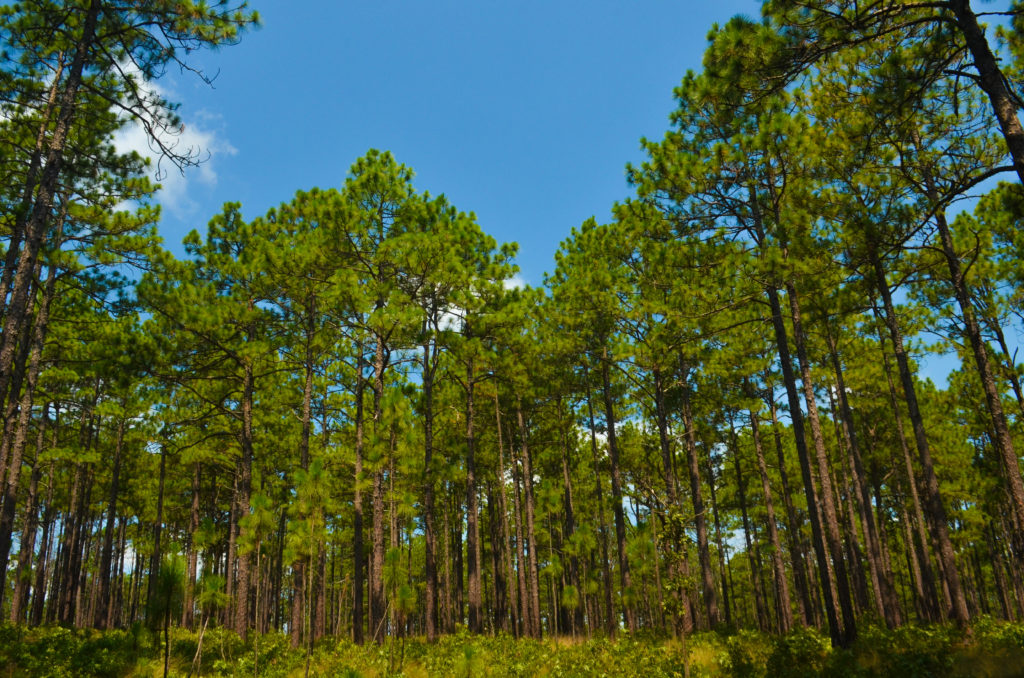The recent forest fires have been wreaking havoc across California since early October. In fact, destructive wildfires are a frequent occurrence in the dry, western state. Such fires are generally bad news as they cause destruction of property and affect air quality. However, are they always bad? Interestingly, the answer is no.
Wildfires can be an intricate part of a forest’s natural cycle, and may even help its survival. One such example lies in front of our eyes in the state of North Carolina, where the longleaf pine finds its home.
Longleaf pine forests across the Southeastern United States are one of the most diverse environmental systems in North America. At one point in time, they covered about ninety million acres of land which, unfortunately, has decreased to only about three million acres. Human development and exclusion of fires by human effort are largely responsible for this decline. Longleaf pines are adapted to fire cycles; preventing fires actually hurts the health of the forest. Native Americans realized this correlation and rarely intervened whenever lightning induced fires, which were common events in the Sandhills region, a major home of the longleaf pines located in North Carolina, South Carolina, and Georgia.When the early European settlers came over, they realized the potential of pine resin in shipbuilding. Very soon, North Carolina’s pine forests became a supply line of naval stores for the UK’s Royal Navy. These early settlers however still continued to burn fires like the natives and thereby contributed to the health of the ecosystem. It was only with growth in plantation forestry came an urge to desperately eliminate fires.

The Sandhills region is home to about a thousand different plant species, the dominant species being the longleaf pines. With their long needles, the pines produce a bright, shiny green canopy growing atop massively tall trunks.Additionally, the forests support a wide variety of animals amounting to 160 different species of birds, including the endangered red-cockaded woodpeckers, a large number of salamanders, toads, frogs, the hognose snakes, and fox squirrels, and many other species. In the twentieth century, firefighting prevented the regeneration of longleaf pines, providing non-fire resistant species a competitive edge. That, coupled with increasing human settlement, reduced longleaf pine forest covers. In 1963, the remnants of the natural home of the longleaf pines were brought under the state parks system when Weymouth Woods was established. Since then, simulated prescribed fires are used systematically as a conservation tool to restore and maintain the longleaf pines.
An unexpected player in the conservation effort is the US military. The military base Fort Bragg, bordering the towns of Fayetteville and Southern Pines in North Carolina, is home to some of the world’s largest biodiversity reserves. The army recognizes that maintenance of the natural environment is crucial. The live ammunition exercises conducted by the military in this base already help protect many of the plant species, some of which are exclusive to Fort Bragg. If these rare plants are not preserved, most of the world’s populations of these species will be lost. Understanding the need of the hour, the military installation is taking one further step: in collaboration with the North Carolina Botanical Garden, they have launched an effort to reintroduce some of the plant species at risk into the Sandhills ecosystem.
Weymouth Woods Sandhills Nature Preserve, a North Carolina State Park in the Moore County around Fort Bragg, offers a great snapshot of the magnificent pine forests that once covered the southeastern United States. During my visit, I was surprised by the wide variety of wildlife I encountered within a short period along the sandy trails. This included a large number of dragonflies, skinks, a moccasin, and not to mention the diversity of plants that coexist in the Sandhills pine forests. If you are intrigued by the unique nature and ecology of the longleaf pines, their role in North Carolina’s history, or simply take pride in being a ‘Tar Heel’, I definitely recommend visiting this place. You will not be disappointed in this treasure trove of nature.
Peer edited by Caitlyn Molloy.
Follow us on social media and never miss an article: